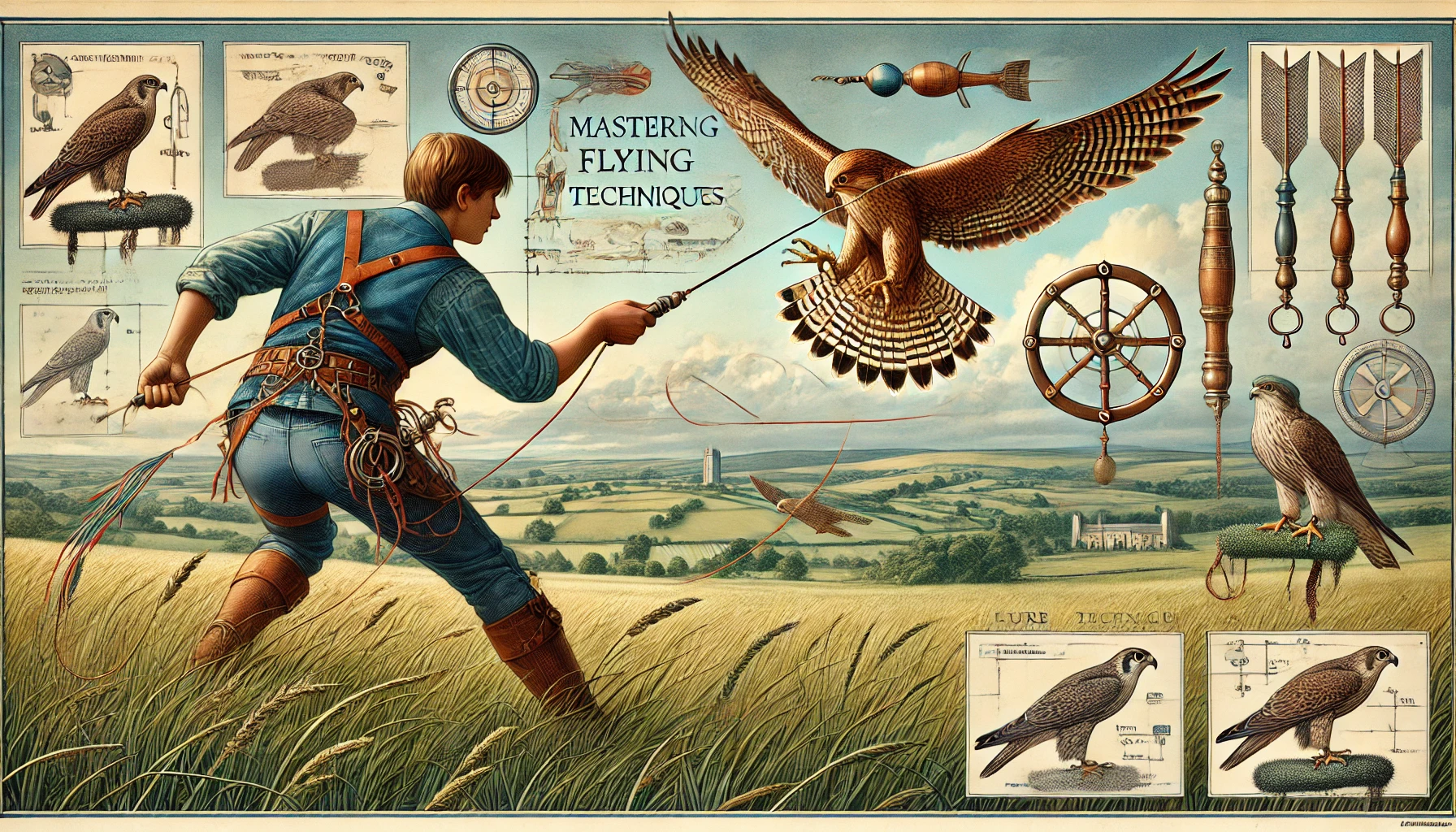Mastering Lure Flying Techniques
- Understand Your Falcon: Learn the unique characteristics, strengths, and weaknesses of your falcon to tailor training sessions effectively.
- Lure Swinging Basics: Get a good grip and practice swinging the lure in smooth arcs to get your falcon’s attention.
- Timing Is Key: Release the lure at the right moment to keep your falcon engaged and on point.
- Use Visual and Sound Cues: Incorporate visual signals and calls to create a more immersive training experience for your bird.
- Consistency Matters: Stick to a regular training schedule to build trust and improve performance progressively.
- Reward and Reinforce: Always reward your falcon with food or praise after successfully completing a lure flight to reinforce good behavior.
- Safety First: Ensure the training environment is safe for both you and your falcon, free from any distractions or hazards.
- Seek Guidance: Don’t hesitate to reach out to experienced falconers for tips and support as you develop your skills.
By following these key points, you can ensure your falconry training is effective, engaging, and enjoyable for both you and your magnificent bird.
Captivating Lure Flying Techniques: A Falconer’s Guide
Hello, fellow adventurers! Imagine for a moment you’re in the lush, emerald fields of Ireland, where the weather is as unpredictable as a falcon darting through the sky. Just like a skilled shepherd guiding their flock with precision and care, mastering the art of lure flying involves a series of elegant maneuvers that sharpen your bond with your majestic bird of prey.
Welcome to Learn Falconry, the global home for falconry enthusiasts who want to dive deeper into this fascinating world. Our expert team is dedicated to sharing the ins and outs of this timeless practice. Whether you’re a curious beginner or a seasoned falconer looking to brush up on your skills, this article about lure flying techniques will be your ultimate guide.
Think of lure flying as a vital dance between you and your bird, where each move and signal is understood and appreciated. This technique not only strengthens the connection between you and your winged companion but also ensures that your raptor stays fit and sharp, ready for the real hunts.
So what’s the catch? Why should you keep reading? Well, imagine mucking about in the Irish countryside, trying to round up a herd of sheep without understanding the proper calls and movements. Chaos, right? Similarly, without mastering lure flying techniques, you’d be missing out on a huge part of what makes falconry so magical.
Stay with us as we unfold the steps to becoming a lure flying expert, ensuring you and your falcon perform in harmony, like a perfectly choreographed dance in the sweeping Irish meadows. This article promises to equip you with all the knowledge to make lure flying an exhilarating and rewarding experience.
Ready to soar to new heights? Let’s dive in!
Mastering Falcon Lure Techniques: A Comprehensive Guide
Lure flying is an essential part of falconry training and one of the most fascinating techniques used by falconers. Whether you’re just starting or aiming to fine-tune your falcon’s skills, understanding the intricacies of lure flying can significantly enhance your training sessions. This article will delve into the essentials of lure flying, providing insights into various falcon lure techniques and the benefits of training with lures.
What is Lure Flying?
Lure flying involves using a lure’a weighted object with feathers or bait attached’to simulate prey for your falcon. The objective is to mimic the flight patterns of the falcon’s natural prey, encouraging the bird to chase and capture the lure. This technique helps maintain the falcon’s fitness, builds its hunting skills, and strengthens the bond between the falconer and the bird.
Lure flying isn’t just a training method; it’s also a way to provide your bird with valuable exercise. This can prevent health issues and improve your falcon’s agility and reaction time. If you’d like to learn more about the physical benefits of lure flying, visit our page on Falcon Health and Nutrition.
Essential Falcon Lure Techniques
- Swinging the Lure: One of the primary falcon lure techniques involves the swinging of the lure in a circular motion above the falconer’s head. This motion attracts the falcon’s attention and simulates the flight of a bird. As the falcon approaches, the lure is tossed out to encourage a catch.
- Target Launcher: Advanced falconers use a target launcher to propel the lure into the air, requiring the falcon to track and chase it from a greater distance. This method is excellent for training fast, high-flying species. For more nuanced techniques and the equipment required, check out our Falconry Equipment section.
Training with Lures
Training with lures isn’t as simple as attaching a piece of bait and tossing it into the air. It requires strategy, timing, and understanding of your falcon’s behavior.
- Start Slow: When beginning, it’s crucial to start slow and ensure that your falcon is comfortable with the lure. Introduce the lure in a controlled environment and reward your falcon for showing interest. For more beginner tips, visit Falconry for Beginners.
- Consistent Training: Consistency is key. Regular training sessions help reinforce the learned behaviors. Develop a routine that includes a mix of free flights and lure chasing. This keeps the falcon engaged and sharpens its hunting instincts. Check out our Basic Training Techniques for more insights.
- Adjust Techniques Per Species: Different species of falcons respond differently to lure flying. Understanding the specific needs and natural behaviors of your falcon can lead to more effective training. Visit our page on Species of Falcons to learn about the unique characteristics of various falcon species.
Advanced Lure Techniques
For those looking to take their training to the next level, advanced lure techniques can be incorporated. These methods might involve complex flight patterns, timed releases, and using technology for precision training. Explore our Advanced Falconry Techniques for more advanced strategies and equipment.
The Importance of Proper Equipment
Using the right equipment is crucial for successful lure flying. Quality lures, well-balanced weight, and suitable materials can make a significant difference in training effectiveness. We invite you to discover more about the Essential Falconry Kit needed for lure flying and other falconry practices.
Lure flying is both an art and a science, blending precise technique with an understanding of your falcon’s instincts and behavior. By mastering these techniques and using the right training methods, you can enhance your falconry experience and forge a stronger bond with your raptor. For further guidance and tips on lure flying and other training methods, visit Training with Lures.
Mastering Lure-Flying Techniques with Learn Falconry
Welcome to Learn Falconry! Today, we’ll dive into the fascinating world of lure-flying techniques. If you’re passionate about falconry, understanding these techniques is crucial for your success. Let’s start with some exciting insights!
Types of Lures
Lure-flying involves using various types of lures to train and exercise falcons. Here are some popular lures:
| Type of Lure | Description |
|---|---|
| Leather Lure | Made from durable leather, mimics the prey for hunting training. |
| Feathered Lure | Features real feathers to attract the falcon’s attention effectively. |
| Swinging Lure | Designed to be swung in circles, simulating the movement of prey. |
Environmental Considerations
When choosing lures, it’s essential to consider the environment where you’ll be flying your falcon. For example:
- Urban Areas: Lightweight lures with bright colors work best.
- Rural Areas: More durable and realistic lures are preferred.
Variety and Replacement
Using a variety of lures can make a significant difference in your falconry training sessions. Here’s a breakdown of why diversity in lures matters:
| Benefit | Explanation |
|---|---|
| Increased Engagement | Different lures keep the falcon interested and engaged. |
| Training Versatility | Helps simulate various types of prey, improving training effectiveness. |
| Durability | Rotating lures can extend the lifespan of each lure. |
Remember to replace your lures regularly to ensure they remain effective and safe for your falcon to interact with.
Performance Dependence
The performance of your lure can greatly depend on specific conditions:
| Condition | Tips for Optimal Lure Performance |
|---|---|
| Weather | Use bright, visible lures on cloudy days; subtle tones on sunny days. |
| Wind Conditions | Heavier lures in strong winds to maintain control; lightweight lures in calm weather. |
Cost
Lures come in various price ranges, and choosing the right one is crucial for both your budget and training quality. Here’s a quick comparison:
| Price Range | Example Lures | Average Cost ($USD) |
|---|---|---|
| Affordable | Soft silicone lures | 3.00 |
| Mid-Range | Feathered or leather lures | 5.50 – 7.00 |
| Premium | High-quality customized lures | 8.99 |
By understanding these aspects of lure-flying techniques, you’ll be better equipped to train and exercise your falcon effectively. Stay tuned as we continue exploring this captivating sport!
Mastering Lure Flying Techniques: The Essentials in 2024
In 2024, the art of lure flying has evolved with new methods and tools to perfect your falconry skills. Whether you’re selecting the right type of lure or adapting to various environmental conditions, having a comprehensive understanding of these techniques is crucial. Here’s a summary of the essential points:
- Types of Lures and Their Applications: Knowing the best types of lures, from spoons and crankbaits to jigs and flies, allows you to mimic prey species effectively and increase your chances of successful falconry.
- Environmental Adaptations: Your choice of equipment and lures should align with the specific environmental conditions of saltwater or freshwater habitats. This ensures durability and effectiveness.
- Variety and Maintenance: Keeping a variety of lures in different sizes and replacing them when necessary helps maintain optimal performance and adaptability to changing conditions.
- Performance Factors: The success of lure flying often depends on weather and water conditions. Experimenting with different lures can help you find the most suitable ones for diverse situations.
- Regional and Conservation Considerations: Various regions use unique trapping methods and lures, combining multiple techniques for higher efficiency. Conservation efforts are paramount to protecting raptor populations from illegal trapping and trafficking.
2024 has brought new lures, regional adaptations, and heightened awareness of conservation. By mastering these essential techniques and staying informed about the latest advancements, you can significantly enhance your falconry practice. Happy lure flying!



